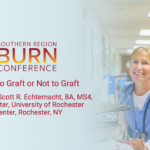Abstract | March 2, 2021
Facial Burns: To Graft or Not to Graft
Learning Objectives
- Be better prepared to manage facial burns non-operatively.
Introduction: Burn injuries to the face are unique in that their functional and cosmetic outcomes are of the utmost importance. As such, the majority of facial burns are often grafted within the early post-injury period in an attempt to achieve the most optimal outcome. The face, however, features characteristics, such as a robust vascular supply that may alter its resiliency and ability to heal without intervention. We sought to review the clinical outcomes for patients presenting to our facility with burns to the face, hypothesizing that the majority of facial burns heal without the need for grafting or revisional surgery.
Methods: A retrospective review of adult and pediatric records from an ABA verified burn center from 2015-2019 was performed. Patients included sustained burn-injuries to the face. Exclusion criteria included patients with initial burn care treatment at an OSH. The primary clinical endpoint was need for surgical grafting or revisional surgery. Data points collected included patient demographics, burn etiology, total body surface area (TBSA) delineated by percentage of burn involving the face, and TBSA delineated into percentage of second and third degree burn. Welch’s t-test was used for statistical comparison between patients requiring grafting and patients not requiring grafting.
Results: One hundred and seven patients met inclusion criteria. 6 patients required initial surgical grafting (5.61%) of their burn wounds, while 101 patients did not require initial grafting (94.39%). Of the 6 patients who required initial surgical grafting, the average number of procedures was 2.17, and only 1 patient required revision surgery for burn contractures. None of the patients in the non-grafted group required revisional surgical procedures for post-burn injury related complications. Patients requiring initial grafting had a higher percentage of facial TBSA than the non-grafted group (1.84% versus 0.65%; p<0.05) and a higher percentage of total body TBSA than the non-grafted group (12.75% versus 2.21%; p<0.05; although, when delineated into percentage of second and third degree burns there was no statistically significant difference. Patients requiring initial grafting had a longer average LOS compared to the non-grafted group (50.8 days versus 3.2 days; p<0.05).
Conclusion: The majority of facial burn wounds heal by secondary intention without functional or cosmetic complications. As such, burn related injuries to the face should be afforded a longer period of demarcation and healing, than non-facial burn wounds, before surgical intervention is considered.

